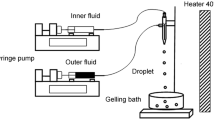Abstract
This paper demonstrates a proof-of-concept approach for encapsulating the insulin and Fe3O4 nanoparticles into size-controllable alginate microcapsules utilizing the electrostatic droplets (ESD) technique. We have established that the combination of ESD and external gelation is quite effective in producing uniform-sized polymer particles. In addition, using the external gelation technique, the droplets containing a sodium-alginate were gelled in situ by immersion in Ca2+, Ba2+, or Cu2+ ions for a few minutes. The results show that different-type divalent cations caused various surface features to appear on the microcapsules (e.g., cracking, orange peel, pitting, splitting, wrinkling, etc.). The particle size can be adjusted from a few micrometers to ca. 1,000 μm by electrostatic force. The microcapsules can be made magnetic by incorporating a super-paramagnetic nanomaterial (e.g., Fe3O4 nanoparticles) during the preparation. The composite magnetic microcapsules are potential candidates for a magnetic-responsive drug delivery system. In addition, our results show that the encapsulation and in vitro release of a model drug, insulin, can enhance the effect of the controlled release. These microcapsules are addressable by an external magnetic field and are capable of loading a model drug and releasing it in a highly differential drug release profile. We have demonstrated that the appropriate magnetic field intensity for different release patterns is predictable, which enables a better application of microcapsules as a smart drug carrier.







Similar content being viewed by others
References
Gombotz WR, Wee SF. Protein release from alginate matrices. Adv Drug Deliv Rev. 1998;31:267–85.
Kikuchi A, Okano T. Pulsatile drug release control using hydrogels. Adv Drug Deliv Rev. 2002;54:53–77.
You JO, Park SB, Park HY, Haam S, Chung CH, Kim WS. Preparation of regular sized Ca-alginate microspheres using membrane emulsification method. J Microencapsul. 2001;18:521–32.
Sugiura S, Oda T, Izumida Y, Aoyagi Y, Satake M, Ochiai A, et al. Size control of calcium alginate beads containing living cells using micro-nozzle array. Biomaterials. 2005;26:3327–31.
Whitesides GM. The origins and the future of microfluidics. Nature. 2006;442:368–73.
Teh SY, Lin R, Hung LH, Lee AP. Droplet microfluidics. Lab Chip. 2008;8:198–220.
Lin YH, Lee CH, Lee GB. Droplet formation utilizing controllable moving-wall structures for double-emulsion application. J Microelectromech Syst. 2008;17:573–81.
Huang KS, Liu MK, Wu CH, Yen YT, Lin YC. Calcium alginate microcapsules generation on a microfluidic system fabricated using the optical disc process. J Micromech Microeng. 2007;17:1428–34.
Huang KS, Lai TH, Lin YC. Manipulating the generation of Ca-alginate microspheres using microfluidic channels as a carrier of gold nanoparticles. Lab Chip. 2006;6:954–7.
Yang CH, Lin YS, Huang KS, Huang YC, Wang EC, Jhong JY, et al. Microfluidic emulsification and sorting assisted preparation of monodisperse chitosan microparticles. Lab Chip. 2009;9:145–50.
Yang CH, Huang KS, Lin YS, Lu K, Tzeng CC, Wang EC, et al. Microfluidic assisted synthesis of multi-functional polycaprolactone microspheres: Incorporation of CdTe quantum dots, Fe3O4 superparamagnetic nanoparticles, and tamoxifen. Lab Chip. 2009;9:961–5.
Huang KS, Lu K, Yeh CS, Chung SR, Lin CH, Yang CH, et al. Microfluidic controlling monodisperse microdroplet for 5-FU loaded genipin-gelatin microcapsules. J Control Release. 2009;137:15–9.
Taylor GI. Electrically driven jets. Proc Natl Acad Sci. 1969;A313:453–75.
Sill TJ, von Recum HA. Electrospinning: applications in drug delivery and tissue engineering. Biomaterials. 2008;29:1989–2006.
Loscertales IG, Barrero A, Guerrero I, Cortijo R, Marquez M, Gañán-Calvo AM. Micro/nano encapsulation via electrified coaxial liquid jets. Science. 2002;295:1695–8.
Bhattarai N, Li Z, Edmondson D, Zhang M. Alginate-based nanofibrous scaffolds: structural, mechanical, and biological properties. Adv Mater. 2006;18:1463–7.
Dai Y, Cobley CM, Zeng J, Sun Y, Xia Y. Synthesis of anatase TiO2 nanocrystals with exposed 001 facets. Nano Lett. 2009;9:2455–9.
Susana M, Bruno S, Eliana BS, Domingos CF. Insulin-loaded alginate microspheres for oral delivery–effect of polysaccharide reinforcement on physicochemical properties and release profile. Carbohydr Polym. 2007;69:725–31.
Tiefenauer LX. Chapter 29: magnetic nanoparticles as contrast agents for medical diagnosis. Nanotechnology in biology and medicine: methods, devices, and applications. Tuan Vo-Dinh. Boca Raton: Taylor and Francis; 2007. p. 1–20.
Kikuchi A, Kawabuchi M, Watanabe A, Sugihara M, Sakurai Y, Okano T. Effect of Ca2+-alginate gel dissolution on release of dextran with different molecular weights. J Control Release. 1999;58:21–8.
Liu X, Chen DW, Xie LP, Zhang RQ. Oral colon-specific drug delivery for bee venom peptide: development of a coated calcium alginate gel beads-entrapped liposome. J Control Release. 2003;93:293–300.
Acknowledgments
This work was financially supported by a grant from the National Science Council of Taiwan.
Author information
Authors and Affiliations
Corresponding author
Rights and permissions
About this article
Cite this article
Huang, KS., Yang, CH., Lin, YS. et al. Electrostatic droplets assisted synthesis of alginate microcapsules. Drug Deliv. and Transl. Res. 1, 289–298 (2011). https://doi.org/10.1007/s13346-011-0020-8
Published:
Issue Date:
DOI: https://doi.org/10.1007/s13346-011-0020-8




